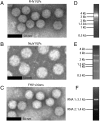Host RNAs, including transposons, are encapsidated by a eukaryotic single-stranded RNA virus
- PMID: 22308402
- PMCID: PMC3277583
- DOI: 10.1073/pnas.1116168109
Host RNAs, including transposons, are encapsidated by a eukaryotic single-stranded RNA virus
Abstract
Next-generation sequencing is a valuable tool in our growing understanding of the genetic diversity of viral populations. Using this technology, we have investigated the RNA content of a purified nonenveloped single-stranded RNA virus, flock house virus (FHV). We have also investigated the RNA content of virus-like particles (VLPs) of FHV and the related Nudaurelia capensis omega virus. VLPs predominantly package ribosomal RNA and transcripts of their baculoviral expression vectors. In addition, we find that 5.3% of the packaged RNAs are transposable elements derived from the Sf21 genome. This observation may be important when considering the therapeutic use of VLPs. We find that authentic FHV virions also package a variety of host RNAs, accounting for 1% of the packaged nucleic acid. Significant quantities of host messenger RNAs, ribosomal RNA, noncoding RNAs, and transposable elements are readily detected. The packaging of these host RNAs elicits the possibility of horizontal gene transfer between eukaryotic hosts that share a viral pathogen. We conclude that the genetic content of nonenveloped RNA viruses is variable, not just by genome mutation, but also in the diversity of RNA transcripts that are packaged.
Conflict of interest statement
The authors declare no conflict of interest.
Figures



References
Publication types
MeSH terms
Substances
Grants and funding
LinkOut - more resources
Full Text Sources
Other Literature Sources

